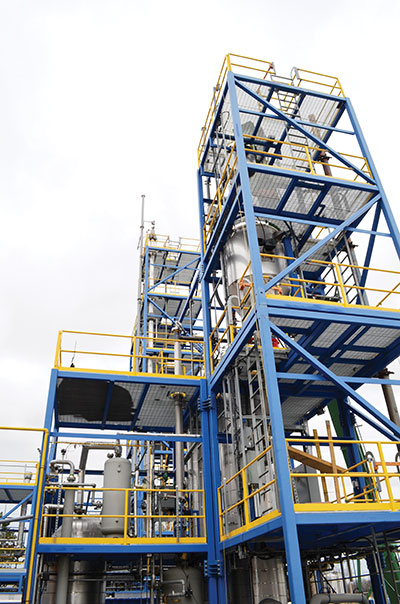
Biochemical leader
June 3, 2014
By
Andrew Macklin
Once the cornerstone of Canada’s petrochemical industry, the border town of Sarnia, Ontario, has had to think smart to avoid the devastating impact of industries packing their bags and leaving town.
Once the cornerstone of Canada’s petrochemical industry, the border town of Sarnia, Ontario, has had to think smart to avoid the devastating impact of industries packing their bags and leaving town.
 |
|
| Woodland Biofuels is one of three companies that has constructed a pilot plant as part of The Bowman Centre at the Western University Research Park in Sarnia.
|
Sarnia’s potential downfall began in the early-2000s with the announcement that Dow Chemical was abandoning its Canadian operation and consolidating its assets in the American market. What could have been a serious blow for the community’s economy instead served as a necessary wake-up call, forcing local officials to come together to explore ideas for how to continue as a thriving industrial community. The result was a commitment to compliment its still-strong petrochemical industry with the growth of a biochemical sector.
Opportunity Knocks
Getting Sarnia’s biochemical industry moving forward has taken a collaborative effort of major partners from across the community and region. Western University (formerly the University of Western Ontario) worked with the Ontario Chemistry Value Chain Initiative, along with City and County officials, to establish a research park at the former Dow chemical site. An NSERC grant of $15 million in seed funding from the Centres of Excellence for Commercialization and Research (CECR) program in 2008 established the BIC, now known as Bioindustrial Innovation Canada.
Bioindustrial Innovation Canada is the amalgamation of the former BIC and the Sustainable Chemistry Alliance. The BIC was integral in delivering funding and networking opportunities together for biochemical startup companies, providing the means necessary to commercialize new biochemical solutions. The BIC has worked to build the biocluster in Sarnia, bringing together networking and financing opportunities to help startup bio companies get projects off the ground. They built a Board of Directors that has provided these opportunities, as well as connections to materials, customers, feedstocks and
labour.
In addition to the CECR funding, a $10 million grant for The Bowman Centre was applied for and received from the Ontario Ministry of Research and Innovation in order to provide the infrastructure at the research park to create bioindustrial lab and pilot plant space for emerging companies and technologies in the biochemical industry.
Those two building blocks have become the foundation for the Western University Research Park, providing funding, networking, research and development resources for the biochemical industry in Sarnia.
The collaborative efforts of the education, association, municipal and corporate stakeholders began to pay dividends a few years later when the Bowman Centre welcomed its first pilot plant.
Woodland Biofuels received funding for its waste-to-biofuel plant in April of 2010 through the Innovation Demonstration Fund. The $12 million facility uses its own proprietary gasification and three-step catalytic conversion process technology to produce sustainable biofuel out of just about any type of biomass, including both agricultural and wood waste. The plant was commissioned in late-2012.
The Woodland production of cellulosic ethanol involves the gasification of biomass into syngas using either the air-blown or steam-blown gasifier. The syngas is conditioned and compressed before transferring to the ethanol reactor where catalytic chemical reactions convert the syngas to ethanol. The company then uses a well-established distillation process to purify the ethanol.
The second company to install a pilot facility in the Bowman Centre at the research park was KmX Corporation, which began operations in October of 2012.
KmX incorporated in 2004 after acquiring the rights to a pervaporation membrane technology. The company acquired a solvent recycling plant in New Church, Virginia, the headquarters for its U.S. subsidiary, KmX Chemical Corporation, and a demonstration facility for its membrane technologies.
At the Bowman Centre in Sarnia, the company is working on a fermentation and filtration system that will produce butanol. Fermenting biomass sugars into butanol can create a cellulosic biofuel that has the potential to be a gasoline substitute. Using biomass sugars to create biochemicals and biofuels is a current focus for the BIC.
The third company involved in the Bowman Centre is GreenCore Composites. In February of 2013, GreenCore announced that it was moving its manufacturing facility from Mississauga to the Bowman Centre at the Western University research park. According to GreenCore president and CEO Geoff Clarke, “the move gives us space to install the new production line which we did not have at our previous location. It also allows us to configure the lines for greater productivity and locates us near the U.S. markets where we expect rapid growth.”
GreenCore’s technology involves extracting nano fibres from various species of wood in the production of thermoplastic materials. In some cases, the fibres are being used to replace glass fibres to create recyclable plastics. The automotive and sports equipment industries are just a few examples of industrial sectors testing with GreenCore at the Bowman Centre
pilot plant.
Education opportunities
The development of the research park has provided Lambton College and Western University with opportunities to provide complimentary education opportunities for their students.
 |
|
| Woodland Biofuels is one of three companies that has constructed a pilot plant as part of The Bowman Centre at the Western University Research Park in Sarnia.
|
Lambton College began an applied research program in 2004-2005, focusing on synthetic and polymer-based materials. As the school expanded on its research capabilities, they began engaging local and regional companies to look for research opportunities that would benefit both the school and the companies involved.
It was at this time that Lambton began working with GreenField Specialty Alcohols, who were interested in research involving biomaterials. The result of working with GreenField, and the expanding research capabilities at Lambton College, was an increase in projects involving the biosector.
“We felt that there was a demand, there was a need for a certain kind of expertise,” says Dr. Mehdi Sheikhzadeh, Dean of Applied Research and Innovation at Lambton College. “No one in Ontario was offering specific training for bio-process operators.”
For Western University, the development of the research park has led to new opportunities within the biochemical sector.
“The research park is a tremendous opportunity, especially for Western students,” says Katherine Albion, director of The Bowman Centre. “Since the park was established, Western has developed a Green Engineering program; the school offers a number of bio-based courses and there are thesis projects underway for students here.”
There is also extensive work being done to build on bio-based educational opportunities by both Lambton and Western. Lambton will launch a new program stream focused on the biosector, called Bio-industrial Engineering Technology, scheduled to welcome its first class of students in the fall of 2015.
Western is looking to both expand on the courses offered at the research park and the complimentary tools that
can be brought in to support the industries onsite.
“One of the opportunities we are currently pursuing is the development of an entrepreneurial centre,” says Tom Strifler, executive director of the research park. “Together with Lambton College and other local partners, we are hoping to set that up in the region. It also builds on what we are doing for our existing clients – that is a new focus area for us.”
Natural infrastructure
Outside of the Lambton College/Western University centres, Sarnia opens up to a vast landscape of massive petrochemical properties. Many of Canada’s largest oil companies call Sarnia home, like Imperial Oil, Suncor, and Shell Canada, as well as major chemical manufacturers like NOVA, DuPont and Praxair.
Sarnia has been hit with a series of closures in its recent past, leaving large patches of land with built-up chemical infrastructure. That infrastructure provides a strong case for companies in the biochemical sector to think about building there.
That infrastructure is at the heart of Sarnia’s bio-industrial park, located amongst the massive oil refineries along the eastern shore of the St. Clair River. The property already includes Lanxess, the world’s largest producer of synthetic rubber, along with TransAlta Energy, located at the adjacent Bluewater Energy Park.
The Sarnia bio-industrial park will also soon be home to the $110 million BioAmber bio-succinic acid production facility. BioAmber chose Sarnia over approximately 100 other locations for its new plant thanks, in part, to the existing infrastructure already in place. The plant expects to be operational some time during the first quarter of 2015.
Succinic acid is used as an acidity regulator in some food and beverage products, as well as in specialized polyesters and resins. The chemical is primarily derived from petrochemicals, but BioAmber has developed a system for creating bio-succinic acid from renewable feedstocks. At full production, BioAmber expects to produce 30,000 tonnes of bio-succinic acid per year.
Additional Resources
The collaboration of industrial, municipal and educational partners has created an environment that can attract additional companies like BioAmber to locate in Sarnia. But there is a second group of local resources that fill out the other key needs of the cluster.
The Sarnia-Lambton Economic Partnership takes a leading role in promoting the community to the global biochemical sector. The company encourages the infrastructure, partnership opportunities, and staff and training capabilities as the driving force for promoting the area as the destination for the biochemical sector. But the cooperation received from the industry itself also plays an important role in attracting businesses to the region.
“The industry wants these companies here,” says Matt Slotwinski, a coordinator with the Partnership. “They are rallying together to try and make these projects happen.”
Ontario Federation of Agriculture vice-president Don McCabe has also been involved with the Sarnia biocluster, providing insight on feedstock and logistics issues as a member of the BIC Board.
“The number one issue for feedstock is logistics at a price,” says McCabe. “You have to have feedstock at a good price in order to make the technology economically viable.”
McCabe cited that there is an approximate annual volume of 500,000 tonnes of sustainable feedstock available within the region. Companies looking to locate in the Sarnia biocluster can utilize that feedstock, especially as farmers in the area get a better grasp of the land use opportunities that exist in order to boost profitability.
The recent establishment of the Bluewater Technology Access Centre will also provide resources for the biocluster in the form of education and training opportunities. Funded in 2013, Technology Access Centres enable colleges to support technological development with industry in order to become more competitive.
“BTAC identifies the projects, and then we will take them to the research and technology division,” says Maike Luiken, director of BTAC.
The result will be BTAC working with Lambton College to provide additional applied research and technology development resources, as well as research, technical, and training services for industrial partners in the biosector in Sarnia.
Moving Forward
The roots of the Sarnia biocluster has now been established with a thriving Western University Research Park and bioindustrial partners throughout the city’s landscape. But according to the BIC, there is still work to be done to grow the biochemical industry in the region.
“What we really need to fill this cluster out is a couple more major investments to come in and expand out the cluster,” says Sandy Marshall, chair of the BIC.
With the structure that has been built, there is little doubt that Sarnia will succeed in fulfilling that need.
Print this page